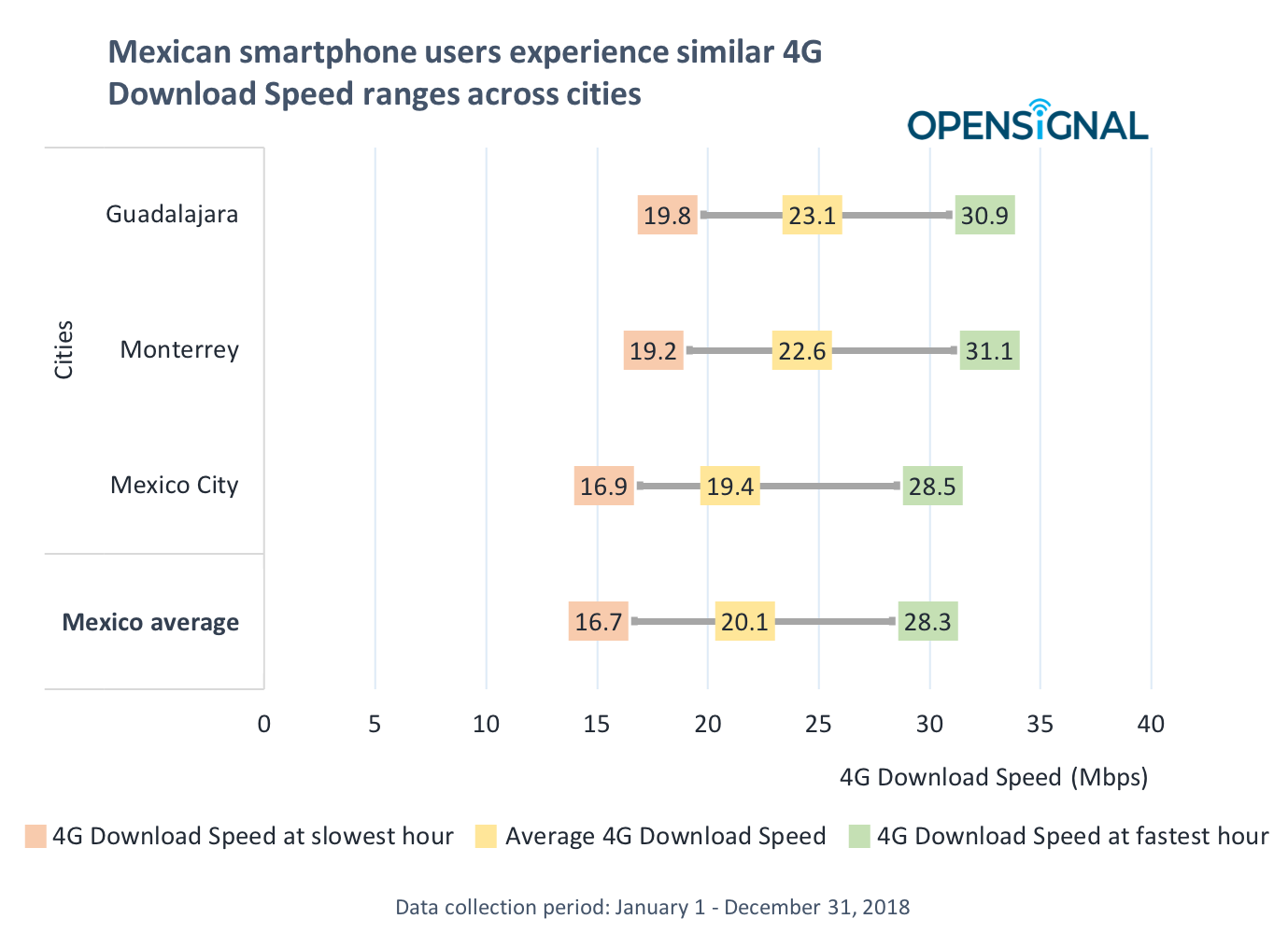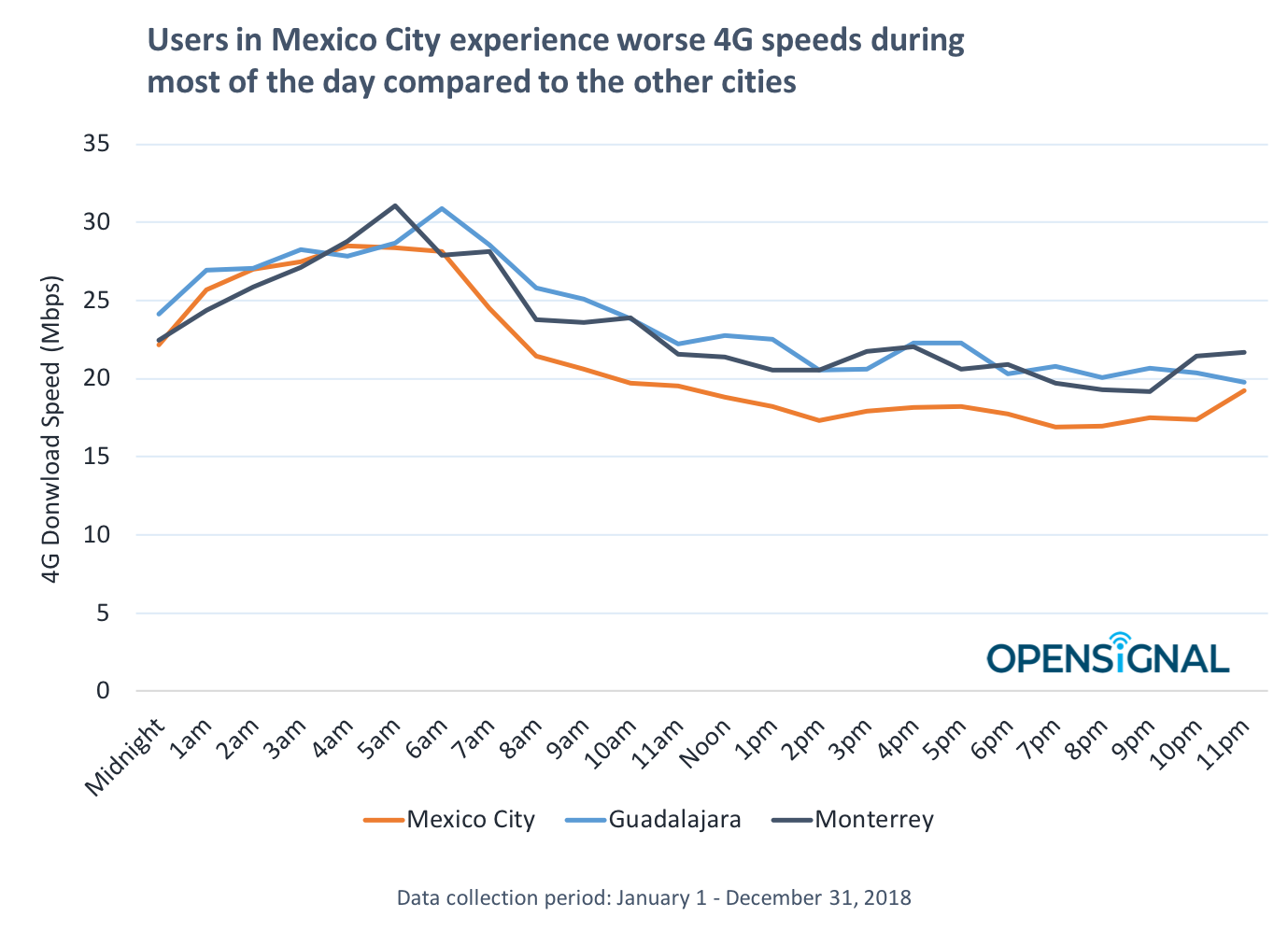Opensignal’s latest report on the 5G opportunity highlighted how smartphone users often experience wide fluctuations in 4G Download Speed throughout the day, and that speeds at the quietest hour can be several times faster than at the busiest hours. We also observed that speed fluctuations experienced in different cities of the same country are often very dissimilar. However, our analysis of the three largest cities in Mexico show remarkably similar speed fluctuations.
4G Download Speeds in Mexico as a whole vary from 16.7 Mbps to 28.3 Mbps, creating a 11.6 Mbps range between slowest times — when the strain on the network is highest because of the large number of users consuming a lot of data — and fastest times — when few people are on the network. Users in Guadalajara, Mexico City and Monterrey all see similar speed variations during the day, with the difference between off-peak and most-congested hours remaining in a remarkably close range between 11.1 and 11.9 Mbps.

Our users in Guadalajara on average experience 23.1 Mbps in 4G Download Speed — just 0.5 Mbps higher than in Monterrey (22.6 Mbps), but 3.7 Mbps faster than the average speed experienced in Mexico City (19.4 Mbps). Interestingly, when the network is slowest in Guadalajara(19.8 Mbps), users can still experience faster speeds than what our users in Mexico City experience during most of the day. Monterrey on the other hand is the city where our users enjoy the fastest speeds at quiet hours. 4G Download Speed in the capital of Nuevo León hits its peak at 5 a.m. — when most smartphone users are asleep — reaching 31.1 Mbps, with a tight lead of 0.2 Mbps on Guadalajara’s fastest speed.
When looking at Mexican cities’ 4G Download Speeds across the hours of the day we see a common trend. Speeds are fastest between 4 a.m. and 6 a.m., they significantly decrease in the morning, then they gradually reach the slowest point in the evening before increasing again around midnight. Such a trend closely mirrors people’s daily habits: networks offer the fastest speeds when fewer people are connected, but when most users consume high volumes of data, speeds drop to their lowest. However, while Guadalajara and Monterrey’s trends mostly overlap, users in Mexico City clearly experience lower speeds than in the other two cities most of the day, suggesting that in the capital mobile operators face bigger congestion challenges. Moreover, our Mexico City’s users experience slowest speeds earlier than users in the other cities. In fact, mobile networks in the capital are most congested at 7 p.m., while in Monterrey and Guadalajara speeds are slowest at 9 p.m. and 11 p.m.

Mobile operators across the world face a huge challenge in providing a consistent mobile experience to their users, regardless of time and location. Having a consistent experience throughout the day is key in enabling smartphone users to seamlessly consume content and services, particularly when using applications that eat up large amounts of data, such as streaming video at higher resolutions. Although our users in the three cities experience similar swings in speeds, Mexico's operators will still need to tackle the challenge of reducing those speed fluctuations recorded throughout the day, and ensure smartphone users can enjoy a more consistent experience at all times.
Opensignal Limited retains ownership of this insight including all intellectual property rights, data, content, graphs & analysis. Reports and insights produced by Opensignal Limited may not be quoted, reproduced, distributed, published for any commercial purpose (including use in advertisements or other promotional content) without prior written consent. Journalists are encouraged to quote information included in Opensignal reports and insights provided they include clear source attribution. For more information, contact [email protected].
